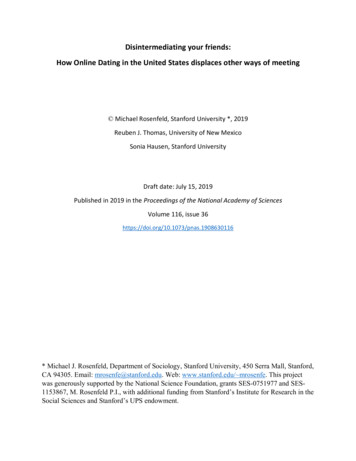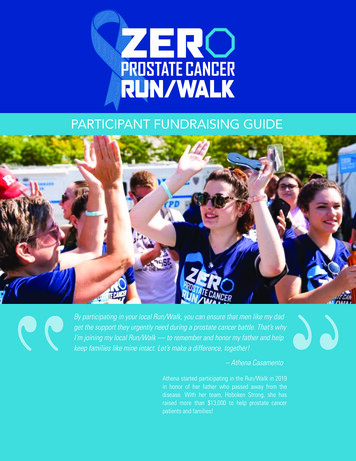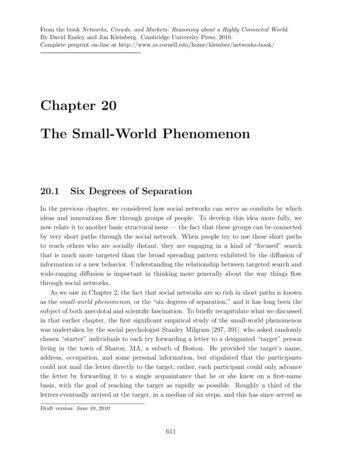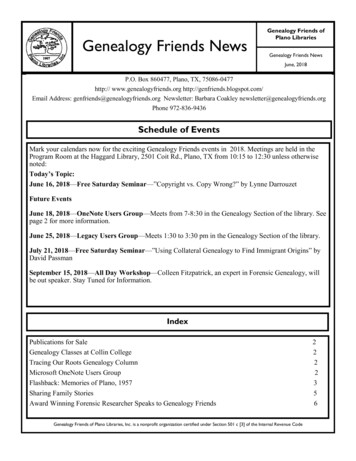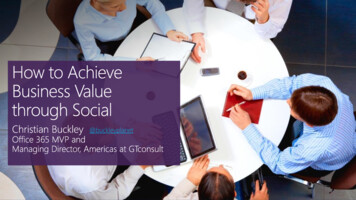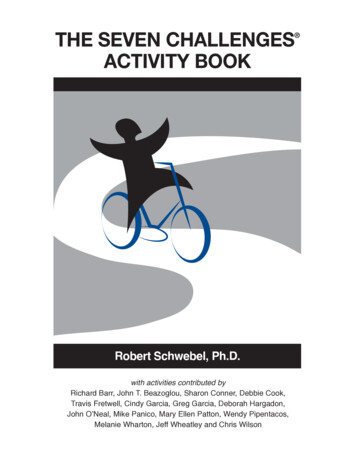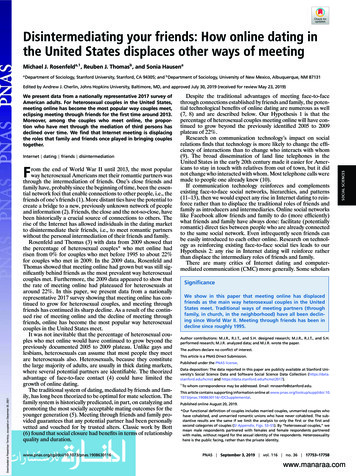
Transcription
Disintermediating your friends: How online dating inthe United States displaces other ways of meetingMichael J. Rosenfelda,1 , Reuben J. Thomasb , and Sonia HausenaaDepartment of Sociology, Stanford University, Stanford, CA 94305; and b Department of Sociology, University of New Mexico, Albuquerque, NM 87131We present data from a nationally representative 2017 survey ofAmerican adults. For heterosexual couples in the United States,meeting online has become the most popular way couples meet,eclipsing meeting through friends for the first time around 2013.Moreover, among the couples who meet online, the proportion who have met through the mediation of third persons hasdeclined over time. We find that Internet meeting is displacingthe roles that family and friends once played in bringing couplestogether.Internet dating friends disintermediationDownloaded at Palestinian Territory, occupied on December 30, 2021From the end of World War II until 2013, the most popularway heterosexual Americans met their romantic partners wasthrough the intermediation of friends. One’s close friends andfamily have, probably since the beginning of time, been the essential network foci that enable connections to other people, i.e., thefriends of one’s friends (1). More distant ties have the potential tocreate a bridge to a new, previously unknown network of peopleand information (2). Friends, the close and the not-so-close, havebeen historically a crucial source of connections to others. Therise of the Internet has allowed individuals in the dating marketto disintermediate their friends, i.e., to meet romantic partnerswithout the personal intermediation of their friends and family.Rosenfeld and Thomas (3) with data from 2009 showed thatthe percentage of heterosexual couples* who met online hadrisen from 0% for couples who met before 1995 to about 22%for couples who met in 2009. In the 2009 data, Rosenfeld andThomas showed that meeting online had grown but was still significantly behind friends as the most prevalent way heterosexualcouples met. Furthermore, the 2009 data appeared to show thatthe rate of meeting online had plateaued for heterosexuals ataround 22%. In this paper, we present data from a nationallyrepresentative 2017 survey showing that meeting online has continued to grow for heterosexual couples, and meeting throughfriends has continued its sharp decline. As a result of the continued rise of meeting online and the decline of meeting throughfriends, online has become the most popular way heterosexualcouples in the United States meet.It was not inevitable that the percentage of heterosexual couples who met online would have continued to grow beyond thepreviously documented 2005 to 2009 plateau. Unlike gays andlesbians, heterosexuals can assume that most people they meetare heterosexuals also. Heterosexuals, because they constitutethe large majority of adults, are usually in thick dating markets,where several potential partners are identifiable. The theorizedadvantage of face-to-face contact (4) could have limited thegrowth of online dating.The traditional system of dating, mediated by friends and family, has long been theorized to be optimal for mate selection. Thefamily system is historically predicated, in part, on catalyzing andpromoting the most socially acceptable mating outcomes for theyounger generation (5). Meeting through friends and family provided guarantees that any potential partner had been personallyvetted and vouched for by trusted alters. Classic work by Bott(6) found that social closure had benefits in terms of relationshipquality and 116Despite the traditional advantages of meeting face-to-facethrough connections established by friends and family, the potential technological benefits of online dating are numerous as well(7, 8) and are described below. Our Hypothesis 1 is that thepercentage of heterosexual couples meeting online will have continued to grow beyond the previously identified 2005 to 2009plateau of 22%.Research on communication technology’s impact on socialrelations finds that technology is more likely to change the efficiency of interactions than to change who interacts with whom(9). The broad dissemination of land line telephones in theUnited States in the early 20th century made it easier for Americans to stay in touch with relatives from out of town, but it didnot change who interacted with whom. Most telephone calls weremade to people one already knew (10).If communication technology reinforces and complementsexisting face-to-face social networks, hierarchies, and patterns(11–13), then we would expect any rise in Internet dating to reinforce rather than to displace the traditional roles of friends andfamily as introducers and intermediaries. Online social networkslike Facebook allow friends and family to do (more efficiently)what friends and family have always done: facilitate (potentiallyromantic) direct ties between people who are already connectedto the same social network. Even infrequently seen friends canbe easily introduced to each other online. Research on technology as reinforcing existing face-to-face social ties leads to ourHypothesis 2: any rise in Internet dating will reinforce ratherthan displace the intermediary roles of friends and family.There are many critics of Internet dating and computermediated communication (CMC) more generally. Some scholarsSOCIAL SCIENCESEdited by Andrew J. Cherlin, Johns Hopkins University, Baltimore, MD, and approved July 30, 2019 (received for review May 23, 2019)SignificanceWe show in this paper that meeting online has displacedfriends as the main way heterosexual couples in the UnitedStates meet. Traditional ways of meeting partners (throughfamily, in church, in the neighborhood) have all been declining since World War II. Meeting through friends has been indecline since roughly 1995.Author contributions: M.J.R., R.J.T., and S.H. designed research; M.J.R., R.J.T., and S.H.performed research; M.J.R. analyzed data; and M.J.R. wrote the paper.yThe authors declare no conflict of interest.yThis article is a PNAS Direct Submission.yPublished under the PNAS license.yData deposition: The data reported in this paper are publicly available at Stanford University’s Social Science Data and Software Social Science Data Collection (https://data.stanford.edu/hcmst and https://data.stanford.edu/hcmst2017).y1To whom correspondence may be addressed. Email: mrosenfe@stanford.edu.yThis article contains supporting information online at 116/-/DCSupplemental.yPublished online August 20, 2019.*Our functional definition of couples includes married couples, unmarried couples whohave cohabited, and unmarried romantic unions who have never cohabited. The substantive results are the same if we limit the analysis to only the first or the first andsecond categories of couples (SI Appendix, Figs. S3–S5). By “heterosexual couples,” wemean male respondents partnered with females and female respondents partneredwith males, without regard for the sexual identity of the respondents. Heterosexualityhere is the public facing, rather than the private identity.PNAS September 3, 2019 vol. 116 no. 36 17753–17758www.manaraa.com
Downloaded at Palestinian Territory, occupied on December 30, 2021view CMC as hollowing out our social well-being by substitutingattention-seeking devices for more rewarding face-to-face interaction (4). If CMC depersonalizes social interaction compared toface-to-face interaction, we might expect people who date onlineto compensate by leveraging suggestions from friends or familyor leveraging their Facebook network to find friends of friends,as some phone dating apps are designed to do.†Whereas family and friends are the most trusted socialrelations, Internet dating and hookup apps such as Tinder,Match.Com, and eHarmony are owned by faceless corporations.‡Why might individuals increasingly rely on matches suggestedby Tinder or Match.Com (Hypothesis 1), and why might anyincrease in online dating displace rather than amplify the roleof dating tips from one’s mother,§ friend, or one’s friend’s friend(contrary to the expectations of Hypothesis 2)?There are several potential reasons why the ascendency ofInternet dating might displace friends and family, despite theexpectations of Hypothesis 2. First, the sets of people connectedto Tinder, Match, and eHarmony are larger than the sets of people connected to one’s mother or friend. Larger choice sets arevaluable to everyone engaged in search (8). Larger choice sets areespecially valuable for people who are searching for somethingunusual or hard-to-find, which is why online dating is even morevaluable for gays and lesbians than it is for heterosexuals (3).Second, individuals might not want to share their dating preferences and activities with their mother or with their friends.Active brokerage of romantic partnerships by a family memberor friend would depend on the broker knowing what both individuals desire in a partner. Taking advantage of Facebook tofind friends of friends for romantic matches (i.e., passive brokerage by friends) might expose dating habits and choices to toobroad an audience. Dating perfect strangers encountered onlineis potentially more discreet than dating a friend’s friend.A corollary to the discretion inherent in online dating is thatthe online precursor to face-to-face meeting inserts a layer ofphysical distance that can have benefits for safety. Messagingstarts through the phone app. If the other person sends a text or apicture that is rude or inappropriate, the sender of the rude message can be blocked within the app and they have no recourse toovercome the block. The ability to block people within the appsis useful to anyone who might feel physically vulnerable meeting a stranger face-to-face (15). Once the face-to-face meetinghas taken place, the security advantage of the phone apps largelydissipates. It is difficult to block the person sitting next to youat the bar, or to permanently extricate oneself from encounterswith a friend’s friend. Asynchronous CMC gives people the timeand distance to frame questions and answers more carefully, tofind communities of interest outside the immediate vicinity, andto share things that might be awkward to share in person (16, 17).Third, Tinder, eHarmony, Match, and the other Internet dating sites are in the business of having up-to-date informationabout the people in the dating pool. Mothers and friends mayhave useful information about a small set of individuals in thedating pool, but how up-to-date is the information? The architecture and ubiquity of the Internet make it easier for Match.comto have up-to-date information on 10 million people, than for amother or friend to have up-do-date information on 20 people.Fourth, the online dating sites have the potential to improvetheir matching algorithms through data analysis, experiments,and machine learning over time (18, 19). In any business where†Phone dating apps Badoo, Hinge, and Down connect to Facebook and offer matches offriends or friends of friends.‡Tinder and Match, 2 of the most popular online dating platforms, are subsidiaries ofthe same corporate parent, Match Group, which is majority owned by IAC.§Personal mediation for dating is heavily gendered, as is most social interaction. Mothersintroduce far more couples than fathers do (14).17754 ng is a core function, the quality of the matching algorithms are vital for the success of the business. Netflix hasimproved its various algorithms for matching people to moviesover time (20). Compared to the 1-way matching problem ofmatching people to movies, the problem of matching people toeach other is a more difficult 2-way matching problem. Whilethere are reasons to be skeptical of the claims that the onlinedating sites make about the scientific nature of their various matching algorithms (21), the online dating sites have atleast the potential for technological advancement, whereas theface-to-face network of friends is a more static technology.Graphical web browsers (introduced around 1995) and smartphones (introduced around 2007) both opened up new marketsfor internet dating. In the case of smart phones, there were 2 separate benefits. The first was location-aware apps (such as Grindrfor gay men) that could suggest matches in one’s immediate area.The second benefit of smart phones was to bring the dating appoff the user’s desktop and into their pocket, making dating accessible everywhere and at all times. The legacy Internet dating sitesthat predated the smart phone era eventually added phone appversions to make their services available on smart phones as wellas on personal computers.¶The information on Match, Tinder, and eHarmony about theindividuals one is interested in could be misleading, of course.Stories abound of online dating scuttled by out-of-date profilephotos, misleading relationship statuses, and overly generousself-descriptions (24). It is not clear, however, that false representations are any more common in online dating than they werein the pre-Internet era (25).ResultsFig. 1 shows updated smoothed graphs (using data from both theHow Couples Meet and Stay Together surveys, hereafter, HCMST2009 and HCMST 2017) of how couples have met by the yearof first meeting for heterosexual couples. Same-sex couples wereearly adopters of Internet services for meeting partners. Becausethe pattern of how heterosexual couples have met has changedmore since 2009, we focus here on the heterosexual couples.The most traditional ways of meeting for heterosexual couples,i.e., meeting through family, meeting through church, meeting inthe neighborhood, and meeting in primary or secondary school,have all been declining sharply since 1940.The timing of the rapid rise of heterosexual couples meetingonline in Fig. 1 corresponds to both of the important technological innovations that helped to spur online dating: theintroduction of the graphical web around 1995 and the introduction and widespread adoption of smart phones after 2007. Theplateau in couples meeting online around 2005 to 2010, and thesubsequent rise, is consistent with increased reliance on smartphones. Separate analyses show that meeting through phoneapps was responsible for at least half of the growth in meetingonline from 2010 to 2017 (SI Appendix, Fig. S1).In 2009, meeting through friends was by far the most commonway heterosexual couples met, and this had been true for 60 ysince the immediate post-World War II period. Since 2009, however, meeting through friends has declined sharply, and meetingonline has continued to grow. As a result of the decline in meeting through friends and the rise in meeting online, heterosexualcouples in the United States are now much more likely to meetonline than to meet any other way. We identify 2013 as the approximate year when meeting online surpassed meeting through¶Legacy Internet dating sites Match.com (founded 1993), Plenty of Fish (founded 2003),and eHarmony (founded 2000) all launched phone app versions in 2010. Across all Internet daters in the United States, the percentage of those who had used a phone app forInternet dating rose from 30% in 2013 to 54% in 2015, from authors’ tabulations from2 surveys from Pew Research (22, 23).Rosenfeld et al.www.manaraa.com
How heterosexual couples have met, data from 2009 and 201745%Met Onlinepercentage who met this way40%Met in Bar or Restaurant35%Met through Friends30%Met Through or AsCoworkers25%Met through Family20%Met in Primary orSecondary School15%Met in College10%Met in Church0%194019501960197019801990200020102020Year Couple MetSOCIAL SCIENCESNeighbors5%Fig. 1. Source: HCMST 2009 and HCMST 2017 waves. Consistent with Rosenfeld and Thomas (3), all trends are from unweighted Lowess regression withbandwidth 0.8 (39), except for meeting online, which is a 5-y moving average because meeting online takes place in the more recent and data-rich part ofthe data (N 2,473 for HCMST 2009 and N 2,997 for HCMST 2017). Friends, family, and coworkers can belong to either respondent or partner. Percentagesdo not add to 100% because the categories are not mutually exclusive; more than one category can apply.Downloaded at Palestinian Territory, occupied on December 30, 2021friends for heterosexual couples in the United States. Previousresearch with the longitudinal follow-ups after HCMST 2009showed that neither breakup rates nor relationship quality wereinfluenced by how couples met, so the retrospective nature of theHCMST “how did you meet” question should not introduce couple survivor bias (3, 8).# Once couples are in a relationship, howthey met does not determine relationship quality or longevity.kThe coding of the “how did you meet” question coded as manycategories as could be identified in every open-ended response.None of the categories are mutually exclusive. Some respondentsmet online and also met through friends; for instance, if the friendhad made the introduction online or if the friend forwarded anonline profile. Some people who met online met through a friendmediated online social-networking website such as Facebook orMyspace. Some respondents had their Internet dating profilescreated and curated by their friends. In all of these cases, meeting online and meeting through friends were both coded. Meetingonline could have grown without displacing the intermediationof friends (as previous literature and Hypothesis 2 would leadone to expect). Fig. 1 shows, however, that the growth of meeting online has strongly displaced meeting through friends.Fig. 1’s apparent post-2010 rise in meeting through bars andrestaurants for heterosexual couples is due entirely to couples#Rosenfeld (8) and Rosenfeld and Thomas (3) both used HCMST 2009’s prospective longitudinal data on couple breakup, based on follow-up with partnered subjects. HCMST2017 has as of yet only retrospective data on couple breakup. Analysis of the HCMST2017 retrospective breakup data show, consistent with prior results from HCMST 2009and its longitudinal follow-ups, that how couples met had no significant effect on thehazard of breakup once decade of meeting was controlled for (SI Appendix, Table S4).kThe only difference we have found in relationships that is correlated with how couples met is the speed of transition to marriage. Heterosexual couples who met onlinetransition to marriage faster (8).Rosenfeld et al.who met online and subsequently had a first in-person meetingat a bar or restaurant or other establishment where people gatherand socialize. If we exclude the couples who first met onlinefrom the bar/restaurant category, the bar/restaurant category wassignificantly declining after 1995 as a venue for heterosexualcouples to meet.Table 1 shows that the rise of meeting online and the declineof meeting through friends among heterosexual couples in theUnited States were both highly significant trends. The Z scoresrepresent tests of whether a line through the data from 1995 to2017 for each way of meeting had a slope significantly different from zero, tested with logistic regressions. More specifically,the Z scores represent the significancelevel of the coefficient Pi,j βi Yj , where Pi,j is the preβi in the equation Ln 1 Pi,jdicted probability that a heterosexual couple meeting in yearj would meet in the ith way; Yj (year of meeting – 1995)if year of meeting 1995 and Yj 0 if year of meeting 1995.All changes (from 1995 to 2017) in how heterosexual couplesmet in Fig. 1 were statistically significant, except for the apparentdecline in meeting in college.We use 1995 as one temporal endpoint for the tests in Table 1for empirical and historical reasons. Fig. 1 shows 1995 to be thebeginning of a sharp increase in the percentage of couples whomet online. The historical rationale for 1995 as the starting pointis that the first popular graphical web browsers, Netscape andInternet Explorer, were introduced in 1994 and 1995. The riseof the graphical web beginning in 1995 created a potential newmarket for Internet dating.Some of the ways of meeting partners are life stage-specific(e.g., meeting in college, meeting in primary or secondaryschool). In SI Appendix, Table S3, we show that the rise in meeting online and the declines over time in meeting through friends,PNAS September 3, 2019 vol. 116 no. 36 17755www.manaraa.com
Table 1. Changes in how heterosexual couples in the UnitedStates met in the Internet eraHow couples metOnlineThrough friendsThrough familyThrough or ascoworkersIn a bar orrestaurantIn primary orsecondary schoolIn churchThrough or asneighborsIn college1995, %2017, %Z score2331539207 4.55 8.47*********1911 5.16***19272.3810754 6.62 2.52****8934 4.54 1.17***23.43Significance*Source: HCMST 2009 and 2017. Heterosexual couples only (N 5,421).The 1995 and 2017 columns are point values for smoothed observedprobabilities. *P 0.05; ***P 0.001 (2-tailed tests).Downloaded at Palestinian Territory, occupied on December 30, 2021meeting through family, meeting through or as coworkers, andmeeting through or as neighbors all remained statistically significant when controlling for age at which subject met partner andsubject gender.Table 2 shows the decline over time in personal intermediationfor couples who met online from the 2009 and 2017 HCMST surveys. In the 2009 HCMST survey, 11.2% of the couples who metonline met through some form of third-person intervention. Inthe 2017 HCMST survey, only 3.7% of couples who met onlinemet through the intervention or mediation of a friend or otherthird person. Eighty-nine percent of couples who met onlinefrom the 2017 survey were previously strangers, meaning therewas no personal connection between the respondent and partner before they met online. Of the couples who met online, thepercentage of those who were perfect strangers increased significantly not only across survey years (shown in Table 2) butalso and significantly as a function of later years of meeting (SIAppendix, Table S5).Stories from HCMST 2017 that reflect online meeting withoutpersonal intermediation include: “We found each other through[dating site]. We met in person at a local grocery store. We thenproceeded to hang out with each other every single day for thenext few months,” and “We met online. We had drinks one nightand were friends for a while then got into a serious relationship.”An example of an online meeting brokered by a third personfrom HCMST 2017 starts this way: “We first met on Facebook.I was asked by his then girlfriend to join his new group. Abouta week later, he and his girlfriend had a falling out. . . He messaged me. . . I took my vacation time from work, drove across thecountry where I met the love of my life!”The results reflect support of Hypothesis 1, as the percentage of heterosexual couples meeting online has surged in thepost-2009 smart phone era. Because the results show that meeting online has displaced meeting through friends and meetingthrough family, we find evidence to reject Hypothesis 2, whichled us to expect that online dating would reinforce existingface-to-face social networks.at first marriage and the independence of young adults has removed dating and matchmaking from the oversight of parents (5).The rapid adoption of smart phones in the United States (26)has spurred the increase in adoption of online dating. Tinder,the leading United States phone dating app, was first released in2012. Grindr, the leading dating and hookup app for gay men,was released in 2009, helping to initiate the phone app phase ofInternet dating. As people have come to know others who foundpartners through online dating, the stigma against online datinghas waned (27). As the number of users of the online dating siteshas increased, the primary advantage of the online dating sites(i.e., a large choice set of potential partners) has also increased.Contrary to the scholarship about how previous technologieshave reinforced face-to-face social networks, and contrary toHypothesis 2, Internet dating has displaced friends and familyfrom their former roles as key intermediaries in the formationof new unions. Disintermediation, i.e., the removal or subordination of the human intermediary between 2 parties, is a fundamental social outcome of the Internet. Human travel agentsused to be necessary to book hotel and airline flights, untilthe Internet travel brokers disintermediated the human travelagents (28). Despite the disintermediation of friends and family from the matchmaker role, friends and family of course havemany other important functions. Friends and family are likely toremain important even if other intermediaries, such as humantravel agents, see their roles and numbers diminish.Data and Methods. We use the HCMST 2017 (29) dataset alongwith wave 1 of HCMST 2009 (30). Both HCMST surveys werenationally representative surveys of English literate adults in theUnited States (see SI Appendix, Table S1 for some summarystatistics). In both HCMST surveys, subjects were asked an openended question, “Please write the story of how you and [partnername] first met and got to know one another, and be sure todescribe ‘how’ and ‘where’ you first met.” Subjects who wrotetoo little were prompted several times to write more. There were2,495 answers from subjects with heterosexual partners to the“how did you meet” in HCMST 2009 and an additional 2,997from HCMST 2017, with no duplication of respondents betweenthe two surveys. The HCMST surveys are the only nationallyrepresentative surveys that we know of that include open textquestions about how couples met.The “how did you meet” question is retrospective because thequestion can only be asked about relationships that have alreadyformed. In HCMST 2009, the “how did you meet” question wasasked only of subjects who were partnered at the time of thesurvey. In HCMST 2017, the “how did you meet” question wasTable 2. Couples who met online increasingly did so withoutthird-person intermediariesRole of othersin online meetingSurvey year2009Discussion. The apparent displacement of meeting through friendsPreviously strangersMediated by friendReconnectedTotalNMedian year of meetingTest for independenceby meeting online suggests a process of technology-driven disintermediation. Individuals used to need personal intermediaries,usually friends or family members, to introduce them to new people. Now that the Internet makes a large choice set of potential partners available, the intermediation of friends and familyis relied upon less. The role of family as matchmaker had beenalready in decline for most of the late 20th century, as later ageSource: HCMST, 2009 and 2017. Heterosexual couples only. “Previouslystrangers” means that before online meeting, subject and partner did notknow each other. “Mediated by friend” means subject and partner werebrought together online by a friend or other third person. “Reconnected”means subject had known partner in the past and reconnected online.**P 0.01.17756 2%7.8%100%1792005Survey year201789.5%3.7%6.8%100%3232012χ2 10.6** on 2degrees of freedomRosenfeld et al.www.manaraa.com
HCMST 2009 and 2017 were internet surveys, conducted bythe survey firm GfK (formerly Knowledge Networks), using subjects who were regular survey subjects in an established panel.Subjects were recruited into the GfK panel by random digitdialing and by address-based sampling. Subjects who did nothave Internet access at home were given Internet access anda device with which to answer regular surveys. The quality ofrepresentative Internet surveys such as the GfK panel has beenshown to equal or exceed the quality of the best representativephone surveys (33, 34). Response rates were 71% in HCMST2009 and 60% in HCMST 2017. Considering historical data onthe rate at which subjects answered initial requests to join theGfK panel at some prior time, and the rate at which subjectscompleted their initial demographic surveys (35), the cumulative response rate is 13% for HCMST 2009 and 11% forHCMST 2017.†† Survey response rates have declined over timefor GfK, as they have for other survey companies and all surveymodes (37, 38).** For††Downloaded at Palestinian Territory, occupied on December 30, 2021a comparison of how couples met in the 1970 to 2009 period, when separateinformation is available from both HCMST 2009 and HCMST 2017, see SI Appendix.We show a bias in the data against recollection of friendships from the past, a biasthat is known in the literature on ego network generation (32). As our results show asharp decline in meeting through friends in the most recent years, our results and therecall bias against the recollection of friends are in opposite directions.1. S. L. Feld, The focused organization of social ties. Am. J. Sociol. 86, 1015–1035 (1981).2. M. Granovetter, The strength of weak ties. Am. J. Sociol. 78, 1360–1380 (1973).3. M. J. Rosenfeld, R. J. Thomas, Searching for a mate: The rise of the internet as a socialintermediary. Am. Sociol. Rev. 77, 523–547 (2012).4. S. Turkle, Reclaiming Conversation: The Power of Talk in a Digital Age (Penguin Press,New York, NY, 2015).5. M. J. Rosenfeld, The Age of Independence: Interracial Unions, Same-Sex Unions, andthe Changing American Family (Harvard University Press, Cambridge, MA, 2007).6. E. Bott, Family and Social Network: Roles, Norms, and External Relationships inOrdinary Urban Families (Tavistock, London, UK, 1957).7. J. T. Cacioppo, S. Cacioppo, G. Gonzaga, E. L. Ogburn, T. J. VanderWeele, Marital Satisfaction and break-ups differ across on-line and off-line meeting venues. Proc. Natl.Acad. Sci. U.S.A. 110, 10135–10140 (2013).8. M. J. Rosenfeld, Marriage, choice and couplehood in the age of the internet. Sociol.Sci. 4, 490–510 (2017).9. J.
www.manaraa.com SOCIAL SCIENCES Disintermediating your friends: How online dating in the United States displaces other ways of meeting Michael J. Rosenfelda,1, Reuben J. Thomasb, and Sonia Hausena aDepartment of Sociology, Stanford University, Stanford, CA 94305; and bDepartment of Sociology, University of New Mexico, Albuquerque, NM 87131 Edited by Andrew J. Cherlin, Johns Hopkins University .
